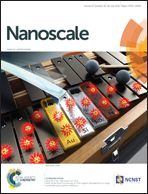Directing lineage specification of human mesenchymal stem cells by decoupling electrical stimulation and physical patterning on unmodified graphene
Abstract
The organization and composition of the extracellular matrix (ECM) have been shown to impact the propagation of electrical signals in multiple tissue types. To date, many studies with electroactive biomaterial substrates have relied upon passive electrical stimulation of the ionic media to affect cell behavior. However, development of cell culture systems in which stimulation can be directly applied to the material – thereby isolating the signal to the cell-material interface and cell–cell contracts – would provide a more physiologically-relevant paradigm for investigating how electrical cues modulate lineage-specific stem cell differentiation. In the present study, we have employed unmodified, directly-stimulated, (un)patterned graphene as a cell culture substrate to investigate how extrinsic electrical cycling influences the differentiation of naïve human mesenchymal stem cells (hMSCs) without the bias of exogenous biochemicals. We first demonstrated that cyclic stimulation does not deteriorate the cell culture media or result in cytotoxic pH, which are critical experiments for correct interpretation of changes in cell behavior. We then measured how the expression of osteogenic and neurogenic lineage-specific markers were altered simply by exposure to electrical stimulation and/or physical patterns. Expression of the early osteogenic transcription factor RUNX2 was increased by electrical stimulation on all graphene substrates, but the mature marker osteopontin was only modulated when stimulation was combined with physical patterns. In contrast, the expression of the neurogenic markers MAP2 and β3-tubulin were enhanced in all electrical stimulation conditions, and were less responsive to the presence of patterns. These data indicate that specific combinations of non-biological inputs – material type, electrical stimulation, physical patterns – can regulate hMSC lineage specification. This study represents a substantial step in understanding how the interplay of electrophysical stimuli regulate stem cell behavior and helps to clarify the potential for graphene substrates in tissue engineering applications.


 Please wait while we load your content...
Please wait while we load your content...